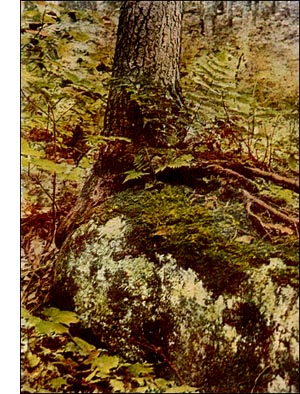Peat Mosses
 Genus SPHAGNUM
Genus SPHAGNUMPeat-mosses are common, growing in more or less compact green or purple patches on the surface of bogs, or along mountain springs and rivulets, or even floating on water. The genus is an easy one to recognise and the plants form an attractive feature of one's walk through woods or over fen-land.
The name Sphagnum was used by the ancient botanists Theophrastus, Dioscorides, and Pliny to indicate certain non-flowering plants. The name , was restricted to a more limited use in 1719 by Johann Dillenius, a German, who was the first professor of botany at Oxford.
The plants are soft and weak-stemmed mosses, generally of large size, white or yellow, light green or sometimes red. The stems appear almost simple with clusters of branches at the summit and on the sides ; the branches at the summit are grouped to form a dense rosette (capitulum), while each side cluster (fascicle) consists of from 2 to 7 or more branches, some spreading and some appressed to the stem. A cross section of the stem shows three zones of cells-the outer (cortex) of large loose cells, the central of pithy cells and the intermediate of woody cells.
The leaves are translucent, without veins, and consist of a single layer of two kinds of cells:
(1) Large colourless and transparent cells (utricles), generally perforated and lined with spiral or circular thickenings (fibrils) to secure them against collapse. They have lost the cell-contents which were present in a younger stage and are, when dry, filled with air.
(2) Smaller cells (ducts), containing active cell-contents and leaf-green. They are narrowly linear and form a net of rhomboidal or hexagonal meshes around the large cells. The stem-leaves are distant.
obliquely inserted, erect or bent downward, flat or concave, tongue-shaped, oval, inserted at the small or large end generally obtuse. The branch-leaves are smaller, round, oval or lance-like, concave or rolled-up lengthwise. Each leaf apex overlaps the base of the next leaf above and every fifth leaf lies in a perpendicular line on the stem, directly over the first leaf counted, that is they are five ranked.
The veil (calyptra) is a ragged membrane left at the base of the spore-case as the latter grows.
The spore-cases are chestnut brown, globular, without teeth.
Normally they are in the crown (capitulum) of the plant, but by an elongation of an erect branch near the apex of the stem they are often left behind so as to appear to have grown from the side.
The pedicels are thick and stocky. [The Sphagnum pedicel (Pseudopodium) does not have the same origin as the pedicel of other mosses].
The lids (opercula) are flattened in the form of an inverted saucer. These are normally cast off by the contraction of the spore-case wall. Sometimes a lid remains attached at one point and opens to permit spores to escape or closes to protect them. Sometimes, if wet, a lid does not fall, then the spores germinate within the spore-case and the growing embryos, burst the spore-case and escape.
The spores are of two kinds-large four-angled spores (tetrahedral macrospores) and small manyangled spores (polyhedral microspores). The small spores are supposed to be the spores of a parasitic fungus which lives upon the developing spores of the moss. Two hundred and fifty-eight species in all are known, seventy-four being found in North America.
Acute Leaved Peat Moss
Boat Leaved Moss
Pointed Peat Moss
Reddish Peat Moss
Spread Leaved Sphagnum